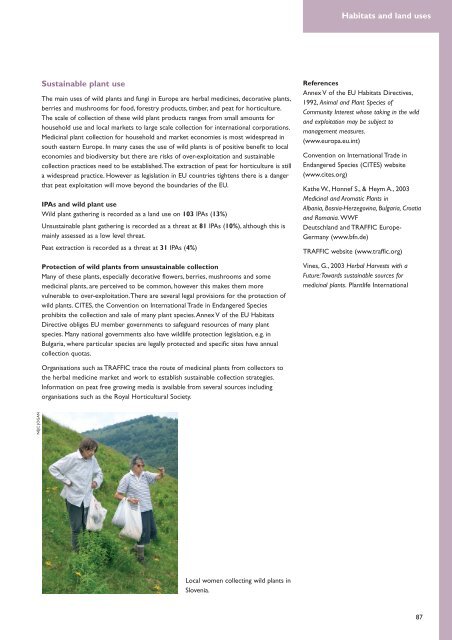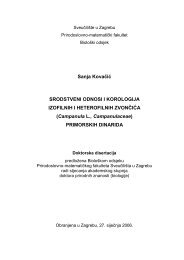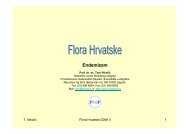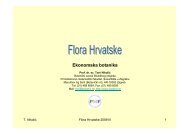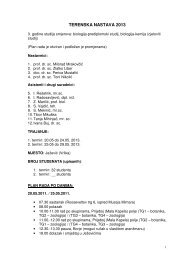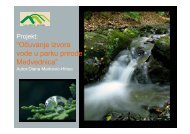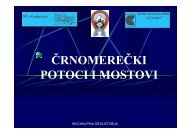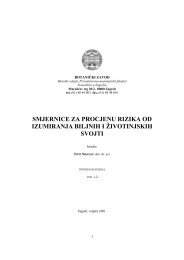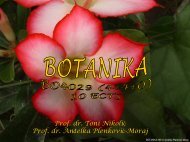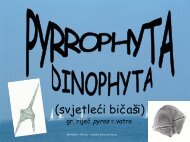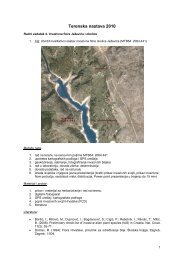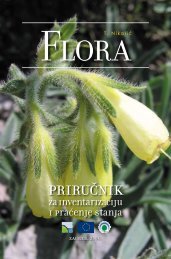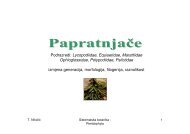important plant areas in central and eastern europe - hirc.botanic.hr ...
important plant areas in central and eastern europe - hirc.botanic.hr ...
important plant areas in central and eastern europe - hirc.botanic.hr ...
Create successful ePaper yourself
Turn your PDF publications into a flip-book with our unique Google optimized e-Paper software.
Habitats <strong>and</strong> l<strong>and</strong> usesSusta<strong>in</strong>able <strong>plant</strong> useThe ma<strong>in</strong> uses of wild <strong>plant</strong>s <strong>and</strong> fungi <strong>in</strong> Europe are herbal medic<strong>in</strong>es, decorative <strong>plant</strong>s,berries <strong>and</strong> mus<strong>hr</strong>ooms for food, forestry products, timber, <strong>and</strong> peat for horticulture.The scale of collection of these wild <strong>plant</strong> products ranges from small amounts forhousehold use <strong>and</strong> local markets to large scale collection for <strong>in</strong>ternational corporations.Medic<strong>in</strong>al <strong>plant</strong> collection for household <strong>and</strong> market economies is most widespread <strong>in</strong>south <strong>eastern</strong> Europe. In many cases the use of wild <strong>plant</strong>s is of positive benefit to localeconomies <strong>and</strong> biodiversity but there are risks of over-exploitation <strong>and</strong> susta<strong>in</strong>ablecollection practices need to be established.The extraction of peat for horticulture is stilla widespread practice. However as legislation <strong>in</strong> EU countries tightens there is a dangerthat peat exploitation will move beyond the boundaries of the EU.IPAs <strong>and</strong> wild <strong>plant</strong> useWild <strong>plant</strong> gather<strong>in</strong>g is recorded as a l<strong>and</strong> use on 103 IPAs (13%)Unsusta<strong>in</strong>able <strong>plant</strong> gather<strong>in</strong>g is recorded as a t<strong>hr</strong>eat at 81 IPAs (10%), although this isma<strong>in</strong>ly assessed as a low level t<strong>hr</strong>eat.Peat extraction is recorded as a t<strong>hr</strong>eat at 31 IPAs (4%)Protection of wild <strong>plant</strong>s from unsusta<strong>in</strong>able collectionMany of these <strong>plant</strong>s, especially decorative flowers, berries, mus<strong>hr</strong>ooms <strong>and</strong> somemedic<strong>in</strong>al <strong>plant</strong>s, are perceived to be common, however this makes them morevulnerable to over-exploitation.There are several legal provisions for the protection ofwild <strong>plant</strong>s. CITES, the Convention on International Trade <strong>in</strong> Endangered Speciesprohibits the collection <strong>and</strong> sale of many <strong>plant</strong> species.Annex V of the EU HabitatsDirective obliges EU member governments to safeguard resources of many <strong>plant</strong>species. Many national governments also have wildlife protection legislation, e.g. <strong>in</strong>Bulgaria, where particular species are legally protected <strong>and</strong> specific sites have annualcollection quotas.ReferencesAnnex V of the EU Habitats Directives,1992, Animal <strong>and</strong> Plant Species ofCommunity Interest whose tak<strong>in</strong>g <strong>in</strong> the wild<strong>and</strong> exploitation may be subject tomanagement measures.(www.europa.eu.<strong>in</strong>t)Convention on International Trade <strong>in</strong>Endangered Species (CITES) website(www.cites.org)Kathe W., Honnef S., & Heym A., 2003Medic<strong>in</strong>al <strong>and</strong> Aromatic Plants <strong>in</strong>Albania, Bosnia-Herzegov<strong>in</strong>a, Bulgaria, Croatia<strong>and</strong> Romania. WWFDeutschl<strong>and</strong> <strong>and</strong> TRAFFIC Europe-Germany (www.bfn.de)TRAFFIC website (www.traffic.org)V<strong>in</strong>es, G., 2003 Herbal Harvests with aFuture:Towards susta<strong>in</strong>able sources formedic<strong>in</strong>al <strong>plant</strong>s. Plantlife InternationalOrganisations such as TRAFFIC trace the route of medic<strong>in</strong>al <strong>plant</strong>s from collectors tothe herbal medic<strong>in</strong>e market <strong>and</strong> work to establish susta<strong>in</strong>able collection strategies.Information on peat free grow<strong>in</strong>g media is available from several sources <strong>in</strong>clud<strong>in</strong>gorganisations such as the Royal Horticultural Society.NEJC JOGANLocal women collect<strong>in</strong>g wild <strong>plant</strong>s <strong>in</strong>Slovenia.87


